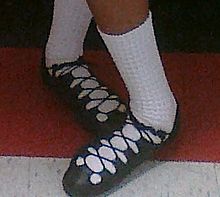Reel (dance)
The reel is a folk dance type as well as the accompanying dance tune type. Of Scottish origin, reels are also an important part of the repertoire of the fiddle traditions of the British Isles and North America.[1] In Scottish country dancing, the reel is one of the four traditional dances, the others being the jig, the strathspey and the waltz, and is also the name of a dance figure (see below).

Irish Dance - Hard Shoes

Irish Dance - Soft Shoes
In Irish dance, a reel is any dance danced to music in reel time (see below). In Irish stepdance, the reel is danced in soft shoes and is one of the first dances taught to students. There is also a treble reel, danced in hard shoes to reel music.
Contents
1 History
2 Reel music
3 References
4 External links
History
The reel is indigenous to Scotland. The earliest reference was in a witchcraft trial of 1590, where the accused was reported to have "daunced this reill or short dance."[2] However, the form may go back to the Middle Ages. The name is probably of Old Norse origins, cognate with Suio-Gothic rulla, meaning "to whirl." This became Anglo-Saxon hreol and Gaelic ruidhle or ruidhleadh, which is the origin of the word now.[3]
After being introduced to Ireland in the late eighteenth century it thrived.[3] Later it was introduced to North America by English, Scottish, and Irish colonists and immigrants. In the United States, reels remain central in the traditions Anglo & African American Old-time music and square dancing, as well as Cajun and Zydeco. In Canada, they are important parts of Cape Breton, Quebecois, and Métis repertoires.[4][5]
Reel music
Reel music is notated in simple meter, either as 2
2 or 4
4. For example, the same reel Rakish Paddy is notated in a 2
2 time signature in O'Neill's Music of Ireland, New & Revisited,[6] but in 4
4 time in English, Welsh, Scottish & Irish Fiddle Tunes,[7] with no change to the note lengths.
All reels have the same structure, consisting largely of quaver (eighth note) movement with an accent on the first and third beats of the bar. A reel is distinguished from a hornpipe in two ways. Firstly they are played with even beats, without an implied dotted rhythm. Secondly they are played twice as fast, implied by the 2
2 time signature. Like most dance music originating in the British Isles, reels are usually composed in binary form, meaning they have two parts (A and B); in most reels each part is repeated (AABB), but in others it is not (ABAB). Each part (A and B) typically has eight bars, which in turn are divisible into four-bar and two-bar phrases. (An exception is the "auld reel" of Shetland which tends to irregular structure and may have been influenced by the Norwegian halling.) The example of Jimmy Shand performing Mairi's Wedding[8] follows the pattern ABABB, giving a pattern of 40 bars. The group of 32 bars (four times eight) is itself repeated three or four times before a second reel is introduced. The grouping of two or more tunes in medleys or "sets" is typical in Celtic dance music.[citation needed] Today many Irish reels are supplemented with new compositions and by tunes from other traditions which are easily adapted as reels. It is the most popular tune-type within the Irish dance music tradition.
Reels are popular in the folk music of South West England. It crossed the Atlantic ocean with Irish and British immigration and thus entered the musical tradition of Atlantic and French-speaking Canada including that of Quebecers and Acadians. Reels are featured in many pieces of Quebec singers and bands; for example: La Bolduc, La Bottine Souriante and even the more modern néo-trad group Les Cowboys Fringants (like the song Mon Pays suivi du Reel des aristocrates).
References
^ Haigh, Chris (2013). Exploring Folk Fiddle. London: Schott. p. 11..mw-parser-output cite.citationfont-style:inherit.mw-parser-output .citation qquotes:"""""""'""'".mw-parser-output .citation .cs1-lock-free abackground:url("//upload.wikimedia.org/wikipedia/commons/thumb/6/65/Lock-green.svg/9px-Lock-green.svg.png")no-repeat;background-position:right .1em center.mw-parser-output .citation .cs1-lock-limited a,.mw-parser-output .citation .cs1-lock-registration abackground:url("//upload.wikimedia.org/wikipedia/commons/thumb/d/d6/Lock-gray-alt-2.svg/9px-Lock-gray-alt-2.svg.png")no-repeat;background-position:right .1em center.mw-parser-output .citation .cs1-lock-subscription abackground:url("//upload.wikimedia.org/wikipedia/commons/thumb/a/aa/Lock-red-alt-2.svg/9px-Lock-red-alt-2.svg.png")no-repeat;background-position:right .1em center.mw-parser-output .cs1-subscription,.mw-parser-output .cs1-registrationcolor:#555.mw-parser-output .cs1-subscription span,.mw-parser-output .cs1-registration spanborder-bottom:1px dotted;cursor:help.mw-parser-output .cs1-ws-icon abackground:url("//upload.wikimedia.org/wikipedia/commons/thumb/4/4c/Wikisource-logo.svg/12px-Wikisource-logo.svg.png")no-repeat;background-position:right .1em center.mw-parser-output code.cs1-codecolor:inherit;background:inherit;border:inherit;padding:inherit.mw-parser-output .cs1-hidden-errordisplay:none;font-size:100%.mw-parser-output .cs1-visible-errorfont-size:100%.mw-parser-output .cs1-maintdisplay:none;color:#33aa33;margin-left:0.3em.mw-parser-output .cs1-subscription,.mw-parser-output .cs1-registration,.mw-parser-output .cs1-formatfont-size:95%.mw-parser-output .cs1-kern-left,.mw-parser-output .cs1-kern-wl-leftpadding-left:0.2em.mw-parser-output .cs1-kern-right,.mw-parser-output .cs1-kern-wl-rightpadding-right:0.2em
^ Newes from Scotland. Declaring the damnable life of Doctor Fian a notable sorcerer, who was burned at Edenbrough in Ianuarie last. London 1591. (Glasgow University Library: Sp Coll Ferguson Al-a.36)
^ ab Francis Collinson. "Reel". In Deane L. Root. Grove Music Online. Oxford Music Online. Oxford University Press.
(subscription required)
^ Haigh, Chris (2009). The Fiddle Handbook. Hal Leonard.
^ Haigh, Chris (2013). Exploring Folk Fiddle. London: Schott. p. 11.
^ Krassen, Miles (1976). O'Neill's Music of Ireland, New & Revisited. p. 158.
^ Williamson, Robin (1976). English, Welsh, Scottish & Irish Fiddle Tunes. p. 69.
^ "Jimmy Shand – Mairi's Wedding". YouTube. Retrieved 7 April 2015.
External links
- Military Two Step
- Gay Gordons
| Wikimedia Commons has media related to Category:Reels (dance). |

